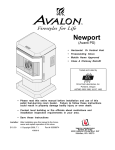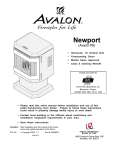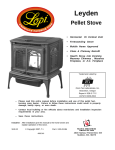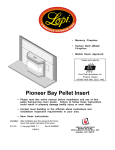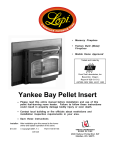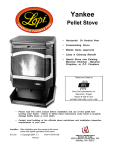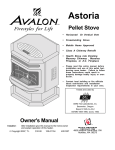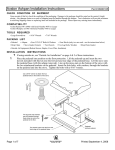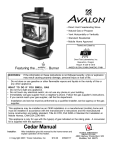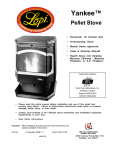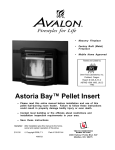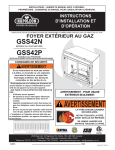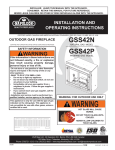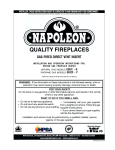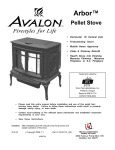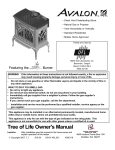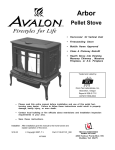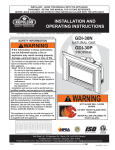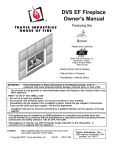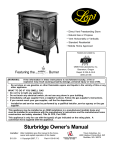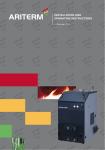Download Astoria Pellet Stove
Transcript
Astoria Pellet Stove • Horizontal Or Vertical Vent • Freestanding Stove • Mobile Home Approved • Class A Chimney Retrofit • Hearth Stove into Existing Masonry Chimney , Masonry Fireplace, or Z.C. Fireplace -- Please read this entire manual before installation and use of this pellet fuel-burning room heater. Failure to follow these instructions could result in property damage bodily injury or even death. -- Contact local building or fire officials about restrictions and installation inspection requirements in your area. Tested and Listed by Omni-Test Laboratories, Inc. Beaverton, Oregon Report # 028–S–42-2 ASTME-1509 1995, ULCC 1482 Installer: After installation give this manual to the homeowner and explain operation of this stove. $10.00 Copyright 2001, T.I. 4011009 Part # 93508126 10850 117th Place N.E. Kirkland, WA 98033 Introduction 1 Introduction We welcome you as a new owner of an Astoria pellet heater. In purchasing an Astoria you have joined the growing ranks of concerned individuals whose selection of an energy system reflects both a concern for the environment and aesthetics. The Astoria is one of the finest home heaters the world over. This manual will explain the installation, operation, and maintenance of this pellet-burning heater. Please familiarize yourself with the Owner's Manual before operating your heater and save the manual for future reference. Included are helpful hints and suggestions which will make the installation and operation of your new heater an easier and more enjoyable experience. We offer our continual support and guidance to help you achieve the maximum benefit and enjoyment from your heater. Important Information No other Astoria heater has the same serial number as yours. The serial number is on the hopper lid. This serial number will be needed in case you require service of any type. Model: To receive full warranty coverage, you will need to show evidence of the date you purchased your heater. Do not mail your Bill of Sale to us. Astoria Serial Number: Purchase Date: We suggest that you attach your Bill of Sale to this page so that you will have all the information you need in one place should the need for service or information occur. Purchased From: Travis Industries Mail your Warranty Card Today, and Save Your Bill of Sale. 4011009 93508126 Safety Precautions 2 • Do not operate the heater if you smell smoke coming from the heater. Turn the M ODE switch to "OFF", monitor your heater, and call your dealer. Gas • Contact your local building officials to obtain a permit and information on any installation restrictions or inspection requirements in your area. Notify your insurance company of this heater as well. Ok • Never use gasoline, gasoline-type lantern fuel, kerosene, charcoal lighter fluid, or similar liquids to start or 'freshen up' a fire in this heater. Keep all such liquids well away from the heater while it is in use. t lan a Se • The exhaust system must be completely airtight and properly installed. The pellet vent joints must be sealed with RTV 500o F. (260o C.) silicone sealant. • Do not unplug the heater if you suspect a malfunction. Turn the MODE SWITCH to "OFF" and periodically inspect the heater. • This unit must be properly installed to prevent the possibility of a house fire. The instructions must be strictly adhered to. Do not use makeshift methods or compromise in the installation. • Never try to repair or replace any part of the heater unless instructions are given in this manual. All other work should be done by a trained technician. • Your heater requires periodic maintenance and cleaning (see "Maintaining Your Heater"). Failure to maintain your heater may lead to smoke spillage in your home. • The viewing door and ashpan must be closed and latched during operation. • Never block free airflow through the open vents of the unit. • Do not operate the heater if the flame becomes dark & sooty of if the firepot overfills with pellets. Turn the MODE SWITCH to "OFF" and periodically inspect the heater (see "Running Your Heater"). Travis Industries A A A A AA A AA A AA AA A A AA AA AAA AAA AA AA AA AA 4011009 • Allow the heater to cool before carrying out any maintenance or cleaning. Ashes must be disposed in a metal container with a tight lid and placed on a non-combustible surface well away from the home or structure. • This heater is designed and approved for pelletized wood fuel only. Any other type of fuel burned in this heater will void the warranty and safety listing. 93508126 Safety Precautions ? • The heater will not operate during a power outage. If a power outage does occur, check the heater for smoke spillage and open a window if any smoke spills into the room. • This heater must be connected to a standard 115 V., 60 Hz grounded electrical outlet. Do not use an adapter plug or sever the grounding plug. Do not route the electrical cord underneath, in front of, or over the heater. • Keep foreign objects out of the hopper. • When installed in a mobile home, the heater must be bolted to the floor, have outside air, and NOT BE INSTALLED IN THE BEDROOM (Per H.U.D. requirements). Check with local building officials. Mobile Home • Disconnect the power cord before performing any maintenance. NOTE: Turning the Mode Switch to "OFF" does not disconnect all power to the heater. This Manual 3 • The exhaust system should be checked twice a year minimum for any build-up of soot or creosote. • Do not throw this manual away. This manual has important operating and maintenance instructions that you will need at a later time. Always follow the instructions in this manual. • Do not touch the hot surfaces of the heater. Educate all children of the danger of a hightemperature heater. Young children should be supervised when they are in the same room as the heater. • Do not place clothing or other flammable items on or near the heater. Because this heater can be controlled by a thermostat there is a possibility of the heater turning on and igniting any items placed on or near it. • Travis Industries, Inc. grants no warranty, implied or stated, for the installation or maintenance of your heater, and assumes no responsibility of any consequential damage(s). Travis Industries 4011009 93508126 Table of Contents 4 Introduction Operation (continued) Introduction ......................................................1 Important Information .........................................1 Manual Mode.....................................................20 Auto Mode ........................................................21 Adjusting the Fan Speed......................................22 Start-Up Sequence.............................................22 "AUGER ON" Light..............................................22 "FAULT" Light ....................................................23 Power Outages..................................................23 Safety Precautions Safety Precautions ............................................2 Specifications Heating Specifications ........................................5 Dimensions.......................................................5 Electrical Specifications......................................5 Fuel.................................................................5 EPA Compliance ................................................5 Maintenance Daily Maintenance (whenever using the stove).........24 Inspect the Burn ...........................................24 Make Sure Pellets are not Piling Up ...................24 Check Firepot for Clinkers ...............................24 Cleaning the Firepot .......................................25 Bi-Weekly Maintenance (or every 10 bags pellets) ....26 Clean the Heat Exchange Tubes.......................26 Vacuum Hopper ............................................26 Clean the Gold Door .......................................26 Opening the Door ..........................................27 Sweep Ash Into Ashpan..................................28 Check Ashpan, Dispose if Necessary................29 Clean the Glass ............................................29 Yearly Maintenance (or every two tons)..................30 Clean the Exhaust Duct ..................................30 Clean the Exhaust Blower ...............................31 Clean the Vent ..............................................31 Check for Air Leaks - Door, Glass and Ashpan ....32 Installation Before you Begin ...............................................6 Installation Options............................................6 Planning the Installation ......................................6 Stove Placement ...............................................6 Floor Protection Requirements..............................6 Clearances - Straight Installation ..........................7 Clearances - Corner Installation ............................7 Venting the Pellet Stove ......................................8 Maximum Venting Distance .............................8 Pellet Vent Type............................................9 Installing the Pellet Vent .................................9 Pellet Vent Termination...................................9 Mobile Home Requirements ..................................10 Outside Air .......................................................10 Alcove Installation Requirements ..........................11 Setting the Restrictor..........................................11 When to Adjust the Restrictor ..........................11 How to Adjust the Restrictor ............................11 Installation Example: Direct "Through the Wall" ........12 Installation Example: Interior Vertical.....................13 Installation Example: Type A Chimney Retrofit.........14 Installation Example: Masonry Fireplace.................15 Installation Example: Zero-Clearance (Metal) Firepl...16 Installation Example: Interior Masonry Chimney .......17 Normal Operating Sounds Normal Operating Sounds ....................................33 Safety Label Safety Label .....................................................34 Warranty Warranty ..........................................................35 Optional Equipment Thermostat .......................................................36 Pellet Log .........................................................37 Operation Safety Notice ....................................................18 Location of Controls ...........................................18 Starting the Heater for the First Time ......................18 Curing the Paint ............................................18 Priming the Auger ..........................................18 Loading Pellets..................................................19 The Two Modes of Operation ................................19 Travis Industries Index 4011009 Index...............................................................38 93508126 Specifications 5 Heating Specifications: Approximate Maximum Heating Capacity (in square feet)* .................................800 to 2,250 Sq. Feet Burn Rate (Pounds per Hour)**.......................................................................1.7 to 5.5 Maximum Burn Time on Low Burn** ................................................................67.5 Hours Hopper Capacity............................................................................................115 Pounds * Heating capacity will vary depending on the home's floor plan, degree of insulation, and the outside temperature. It is also affected by the fuel size, quality, and moisture level. ** Small pellets will increase or decrease the stated burn rates and burn times. Differences of plus or minus 20% depending on fuel quality may occur. Dimensions: This keyhole is for the door handle. Center Line 33-3/8" This tab is for the scraper rod tool. Air Inlet (1-3/4" Outside Diameter) 7-1/4" 4" Diameter Exhaust 1/2" A 17-5/8" 10-1/2” 28" 26-1/2" Weight: 250 Lbs. Electrical Specifications: Electrical Rating .......................................................................................115 Volts, 3.6 Amps, 60 Hz Watts During Start-Up Sequence..............................................................400 (approximately) Watts During Operation............................................................................180 (approximately) Fuel: The unit is designed for wood pellets that comply with the standards set by the Association of Pellet Fuel Industry (density of at least 40 lbs. per cubic foot, 1/4" to 5/16" diameter, length no greater than 1–1/2", 8200 BTU's/lb., moisture under 8% by weight, ash under 1% by weight, and salt under 300 parts per million). If the fuel does not comply to this standard, the unit may not operate as designed. EPA Compliance: This heater has been tested exempt from EPA Phase II Requirements by OMNI Test Labs. Travis Industries 4011009 93508126 Installation 6 Before You Begin READ THIS ENTIRE MANUAL BEFORE YOU INSTALL AND USE THIS HEATER. FAILURE TO FOLLOW THE INSTRUCTIONS MAY RESULT IN PROPERTY DAMAGE, BODILY INJURY, OR EVEN DEATH. Check with local building officials for any permits required for installation of this pellet heater and notify your insurance company before proceeding with installation. Packing List • Thermostat & Wire • Door Latch Tool • Scraper Rod Tool • Brush • Fuses (2) • Lag Bolts (2) Installation Options: • Residential or Mobile Home (see the section "Mobile Home Requirements") • Alcove Compatible (see the section "Alcove Installation") • Horizontal or Vertical Vent • Outside Air Compatible • Vent with L-Vent, L-Vent Fireplace Liner, or Type A Chimney (with adapter) Planning The Installation HINT: Have an authorized Travis Industries dealer install this heater. If you install the heater yourself, have your dealer review your installation plans. HINT: Sketch out a detailed plan of the installation including dimensions. Then verify the dimensions with the requirements listed in this manual. HINT: When determining the location of the stove, locate the wall studs (for horizontal penetrations) and ceiling trusses (for vertical penetrations). You may wish to adjust the stove position slightly to ensure the vent does not intersect with a framing member. HINT: Place the heater outside and load 10 pounds of pellets inside the hopper. Plug the heater in and let it run on HIGH until the pellets run out. This will cure the paint and burn off any oil on the steel, eliminating any smell inside the home. Stove Placement • Stove must be placed so that no combustibles are within, or can swing within (e.g. drapes, doors), 36" of the front of the heater. ? If the stove is placed in a location where the ceiling height is less than 7', it must follow the requirements in the section "Alcove Installation Requirements". HINT: REDUCING CLEARANCES - Clearances may be reduced by methods specified in NFPA 211, listed wall shields, pipe shields, or other means approved by local building or fire officials. • Heater and floor protection must be installed on a level, secure floor. Floor Protection Requirements • The heater must be installed on a non-combustible floor protector extending the full width and depth of the heater and extending 6" in front (Minimum 28" wide by 32-1/2" deep) (minimum .018" thick - 26 gauge) . • Must extend under and 2" to each side and rear of a "Tee" (if used). Travis Industries 4011009 93508126 Installation 7 Clearances - Straight Installation Through the Wall Installations A A A A A A AAAAAAAA AAAAAAAA AAAAAAAA AAAAAAAA AAAAAA AAAAAAAA AAAAAA AAAAAAAA AAAAAA AAAAAAAA AAAAAAAA AAAAAAAA Interior Vertical Vents “Tee” 3” Minimum Floor Protection Clearances - Corner Installation 6” Minimum Through the A AA A AA A AA AAAAAAAAAAAA AAAAAAAAAAAA AAAAAAAAAAAA AAAAAAAAAAAA AAAAA AAAAAAAAAAAA AAAAA AAAAAAAAAAAA AAAAA AAAAAAAAAAAA AAAAA AAAAAAAAAAAA AAAAA AAAAAAAAAAAA AAAAAAAAAAAA AAAAAAAAAAAA AAAAAAAAAAAA Interior Vertical Vents Wall Vents 3” Minimum 45° 45° Elbow 3” Minimum 6” Minimum Floor Protection Note: 2” Minimum 9” Minimum 9” Minimum 6” Minimum AAAAAAAAA AAAAAAAAA AAAAAAAAA AAAAAAAAA AAAAAAAAA AAAAAAAAA AAAAAAAAA AAAAAAAAA AAAAAAA AAAAAAAAA AAAAAAA AAAAAAAAA AAAAAAA AAAAAAAAA AAAAAAAAA AAAAAAAAA 3” Minimum AAAAAAAAAAAAA AAAAAAAAAAAAA AAAAAAAAAAAAA AAAAAAAAAAAAA AAAAAAAAAAAAA AAAAAAAAAAAAA AAAAA AAAAAAAAAAAAA AAAAA AAAAAAAAAAAAA AAAAA AAAAAAAAAAAAA AAAAA AAAAAAAAAAAAA AAAAA AAAAAAAAAAAAA AAAAAAAAAAAAA AAAAAAAAAAAAA 3” Minimum 3” Minimum 2” Minimum “Tee” 3” Minimum 6” Minimum If interior vertical pellet vent is used, the clearance to the backwall is determined by the upward-turning elbow or "Tee". It will vary in depth depending on the brand of pellet vent used (it is approximately 5"). Before placing the heater, connect the elbow or "Tee" and measure off the 3" clearance. Travis Industries 4011009 93508126 Installation 8 Venting the Pellet Stove • PELLET VENT MUST MAINTAIN A MINIMUM 3" CLEARANCE TO ANY COMBUSTIBLE (INSTALL VENT AT CLEARANCES SPECIFIED BY THE VENT MANUFACTURER). • DO NOT CONNECT THE PELLET VENT TO A VENT SERVING ANY OTHER APPLIANCE OR STOVE. • DO NOT INSTALL A FLUE DAMPER IN THE EXHAUST VENTING SYSTEM OF THIS UNIT. • USE AN APPROVED WALL THIMBLE WHEN PASSING THE VENT THROUGH WALLS AND A CEILING SUPPORT/FIRE STOP SPACER WHEN PASSING THE VENT THROUGH CEILINGS (MAKE SURE TO MAINTAIN 3" CLEARANCE TO ANY COMBUSTIBLES. • No more than one tee and 180° of elbows (one tee with two 90° elbows, one tee with one 90° and two 45° elbows, etc.). 33 Feet (max.) Maximum Venting Distance: • Vent must have a support bracket every 5' of pellet vent when exterior of structure 30 Feet The vent height and run must not exceed the distance shown in the shaded region shown to the right. 25 Feet 20 Feet Venting into this shaded area may require restrictor adjustments. See the section “Restrictor Adjustment” for details. 15 Feet 10 Feet NOTE: To achieve optimum performance, we recommend keeping the vent as short as possible (horizontal run especially). 5 Feet Travis Industries 4011009 10 Feet (max.) 5 Feet 0 Feet 0 Feet 93508126 Installation 9 Pellet Vent Type • Must be 4" diameter Type "L"(except for masonry fireplace installations) - or - connect the vent to a factory built type "A" chimney. All vent joints (including adapters, elbows, etc…) must be sealed with 500° F. RTV silicone. Installing the Pellet Vent Seal each vent section (including adapters, elbows, etc...) by injecting a liberal amount of 500° F. RTV silicone into the gap between sections. V RT F. 0° 50 icone Sil • Horizontal sections must have a 1/4" rise every 12" of travel. • Pellet vent connections must be sealed airtight with 500° F. RTV silicone and screwed together with at least three sheet metal screws. Pellet Vent Termination (See the illustration below) • Must have an approved cap (to prevent water from entering) or a 45° downturn. • If the termination is located on a windy side of the house, an approved house shield is recommended to prevent soot from building up on the side of the house. • Must not be located where it will become plugged by snow or other material. • Horizontal terminations must protrude 12" from the wall, verticall terminations require 24". G X A F B D C F H A E NOTE: Measure clearances to the nearest edge of the exhaust hood. A B C D E F G H X Minimum 4' clearance below or beside any door or window that opens Minimum 1' clearance above any door or window that opens Minimum 2' clearance from any adjacent building Minimum 7' clearance above any grade when adjacent to public walkways NOTE: Vent may not terminate in covered walkway or breezeway. Minimum 2' clearance above any grass, plants, or other combustible materials Minimum 3' clearance from any forced air intake of any other appliance Minimum 2' clearance below eaves or overhangs Minimum 1' clearance horizontally from combustible wall Must be a minimum of 2' above the roof Travis Industries 4011009 93508126 Installation 10 Mobile Home Requirements • Outside air is required (used for combustion) - see the directions below. • The heater must be bolted to the floor (Some states do not require this; check with your local building department). See the illustration to the right. • b Use the lag bolts (used to secure the stove to the pallet) to screw the pedestal to the floor. The heater must be grounded to the steel chassis of the mobile home (Some states do not require this; check with your local building department). WARNING: CAUTION: 7/16” Socket a DO NOT INSTALL IN SLEEPING ROOM. THE STRUCTURAL INTEGRITY OF THE MANUFACTURED HOME FLOOR, WALL, AND CEILING/ROOF MUST BE MAINTAINED. Remove the ash pan (see page 29). Outside Air (used for combustion) Must not be drawn from an enclosed space (garage, unventilated crawl space). Travis Industries strongly suggests outside air for all residential installations, especially for those that are energy efficient, air-tight homes. Must not terminate above or within 1' of the chimney termination. • Must have a rain cap or down-turned elbow to prevent water from entering. • This valve must be open (the rod Center Line stove is in operation. Air Inlet (1-3/4" Seal the area around Outside the tube to prevent Diameter) air from entering 1/2" AA Select a location between framing members for the through the wall. outside air hole. AA AAAAAAAAA AAA AAAAAA AA AAA AA AAAAAAAAA AAAAAAAA AAA A AA AA AAA AA AAA AAAAAAAAA AAAAAAAA AAA A AAAAA AAA AAAA AAA A AAA AA AAAA AAAAAAAAA AAAAAAAA AAA A AAAAA AAAAAA AAA AA AA A AAAA A AAAAAAAAA AAAAAAAA AAA AAA AAA AAAAAAAAA AAAA AAAAAAAA AAAA A AAAA AAAAAA AAA AAAAAAAAA AAAAAAAA AAA AAAAAAAA AAAA A AAAAAAAAAA AAAAAAAAA AAAAAAAA AAA A AAAAAAAAA AAAAAAAA AAA A AAAAAAAAA AAAAAAAA AAA A AAAAAAAAA AAAAAAAA AAAAAAAA 10-1/2” Cut a minimum 2" diameter hole in the wall. 1-3/4" Diameter Flex Duct Must be located so that it will not become plugged by snow or other material. Travis Industries parallel with the tube) when the ne • NOTE: ico Must be made with 1 3/4" diameter or larger metal or aluminum duct with a metal screen attached to the end to keep out rodents (P.V.C. or other combustible materials may not be used). We recommend the Travis Industries Outside Air Kit (part # 99200136). Sil • ico ne Must not be over 15' long. Sil • one HINT: Silic • Rain Hood with Rodent Screen 4011009 93508126 Installation 11 Alcove Installation Requirements When the pellet stove is placed in a location where the ceiling height is less than 7' tall, it is considered an alcove installation. Because of the reduced height, the requirements listed below must be met. • Minimum height is 60" • Maximum depth is 48" • Minimum width is 46" • Minimum clearance of 9" on each side and 3" on back Restrictor Adjustment (qualified installers only) In rare cases the vent will produce too much draft for the stove, leading to an inefficient burn, and in some cases, the flame going out. The factory setting is wide open. When to Adjust Restrictor(s): Run the heater with the restrictors open (factory setting). If the fire goes out on low, or if un-burned pellets are expelled from the firepot often (make sure they are un-burned, not just cylindrical embers), the restrictor(s) will require adjustment. Follow the directions below. Adjusting the Restrictor(s) Intake Restrictor Adjustment The intake restrictor acts as a fine adjustment to the airflow where the exhaust restrictor acts as a coarse adjustment. To adjust the restrictor(s), first close the intake restrictor and assess heater performance over time. If the problem is not solved, open the intake restrictor and adjust the exhaust restrictor following the directions listed under "Exhaust Restrictor Adjustment". Use these index marks to gauge restrictor movement. Push in for more restriction (pull out for less restriction). Intake Restrictor Open the hopper and remove the screw holding the left panel in place. Exhaust Restrictor Adjustment (qualified installers only) a) Start the heater and allow it to get up to temperature. Set it to low burn. b) Rotate the restrictor bolt until the indicator tab is at position # 1 (to the left) c) Inspect the flame - if it is in-active and the spent pellets do not jump out of the burnpot, turn the restrictor bolt so the indicator tab is at position # 3. Repeat this process until the flame is active and the spent pellets jump out of the burn pot. Also verify the heater burns correctly on high. Phillips Screwdriver NOTE: you will not notice much change in the flame after adjusting the restrictor. Check stove performance over a long period of time. Restrictor Bolt Indicator Tab Clo 1 Travis Industries se 2 d 3 4 5 6 7 8 Op 9 en 10 4011009 7/16” Socket with Extender 93508126 Installation 12 Installation Example: Direct "Through-the-wall" Installation Horizontal Rain Cap Type "L" Vent Outside Air 12” Minimum AAAAAAAAAAAAA A AAAAAAAAAAAAA AA A AAAAAAAAAAAAA AA A AAAAAAAAAAAAA A AAAAAAAA A AAAAAAAA A AAAAAAAA A AAAAAA A AAAAAAAA AAAAAA AAAAAAAA A AAAAAAAA AAAAAA A AAAAAA AAAAAAAA A AAAAAAAA A AAAAAAAA AA A AA A AA A A AA A AA A AA A AA A AA A AA A AA A AAAAAAAAAAAAAAA AA A AAAAAAAAAA AAAAAAAAAAAAAAA House Shield - prevents discoloration to outside of home - HIGHLY RECOMMENDED Seal each vent section (including 3” Minimum Wall Thimble (note 3” clearance between vent and combustibles) adapters, elbows, V RT F. 0° 50 icone Sil 9” Minimum etc...) by injecting a liberal amount of 500° F. RTV silicone into the gap between sections. Floor Protection 6” Minimum 3” Minimum 12” Minimum 17-5/8” Travis Industries 10-1/2” 4011009 Floor Protection 93508126 Installation 13 Installation Example: Interior Vertical Installation A AAAAAAAAAAAA AAAAAAAA AA AAAAAAAA AA AAAAAAAA AAAAAAAA A AAAAAAAA AAAAAAAA AA AAAAAA AAAAAAAA AAAAAA AAAAAAAA AAAAAA AAAAAAAA AAAAAAAA AAAAAAAA 2” Minimum 3” Minimum “Tee” Outside Air (optional) Type "L" Vent 9” Minimum Floor Protection 6” Minimum Vertical Cap AAAAAAAAAAAAAA AAAAAAAAAAAAAA AAAAAAAAAAAAAA AAA AAAAAAAAAAAAAA AAA AAAAAAAAAAAAAA AAA AAAAAAA AAAAAAAAAA AAAAAAAAAAAAAA AAAAAAAAAAAAAA AAAA AAAAAA AAAAAAA A A A AA AA A AA AA AA A A A A A A A A A AAAAAAAAAAAAA A AAAAAAAAAAA Storm Collar 24” Minimum Roof Flashing Insulation must maintain 3” clearance. Vent must maintain 3” clearance to combustibles. Ceiling Support “L” Vent V RT F. 0° e 50ilicon S Seal each vent section (including adapters, elbows, etc...) by injecting a liberal amount of 500° F. RTV silicone into the gap between sections. 3” Min. 2” Min. Floor Protection Outside air may be drawn from a ventilated crawl space. Travis Industries 4011009 93508126 Installation 14 Installation Example: Class A Chimney Retrofit AAAAAAAAAAAAAAA AA AAAAAAAAA AA AAAAAAAAA AA AAAAAAAAA AA AAAAAAAAA AA AAAAAAAAA AA AAAAAAAAA AA AAAAAAAAA AA AAAAAAAAA AAAAAAA AA AAAAAAAAA AAAAAAA AA AAAAAAAAA AAAAAAA AAAAAAAAA AAAAAAAAA AAAAAAAAA AAAAAA AAAAAA AAAA AAAAAA AAAA AAAA AAAA AAAAAAAAAAAAAAAA AAAA AAAAAAAAAAAAAAAA AAAA AAAAAAAAAAAAAAAA AAAA AAAAAAAAAAAAAAAA AAAA AAAAAAAAAAAAAAAA AAAA AAAAAAAAAAAAAAAA AAAA AAAAAAAAAAAAAAAA AAAAAA AAAA AAAAAA A AAAAAAAAAAAAAAAA AAAAAA AAAAAA A AA A AA AA AAA A AA A AA A A A A A A A A A AAAAAAAAAAAAAAAAA A AAAAAAAAAAAAAA 2” Minimum 3” Minimum “Tee” Outside Air (optional) Type "L" Vent 9” Minimum Floor Protection 6” Minimum V RT F. 0° e 50ilicon S Class A Chimney Storm Collar Seal each vent section (including adapters, elbows, etc...) by injecting a liberal amount of 500° F. RTV silicone into the gap between sections. Roof Flashing Class A Chimney must maintain clearances outlined in the chimney’s installation instructions (usually 2”). Class A Chimney Ceiling Support “L” Vent to Class A Chimney Adapter “L” Vent 3” Min. 2” Min. Floor Protection Outside air may be drawn from a ventilated crawl space. Travis Industries 4011009 93508126 Installation 15 Installation Example: Masonry Fireplace Hearth Stove Vertical Cap “L” Vent Cover Plate (non-combustible) AAAAA AAAA AAAAA AAA A AA AAA AAAA AAAA AA AA AAAAAA AA AAAAAAAAA AAAA AA AAA AA AAAA AA AAAA AA AAA AA AAAA AA AAAAAA AAAA AA AAA AA AA AA AAA AA AA AA AAAA AAA AA AAAAA AA AAAA AA AA AA AAAA AAA AA AAAAA AAAAA AAAAA AA AA AAAA AA AA AAAAA AA AAAA AAAA AA AA AA AAAAA AAAAAA AAAAA AAAAA AA AA AA AA AAA AAAA AA AAAAA AAA AAAA AAAAA AA AA AA AA AAAAA AA AA AAAAA AA AA AAA AA AAA AAAAA AA AA AAAAA AA AA AA AA AA AA AA AA AA AA AA AA AA AA AA AA AA AA AA AA AAA AA AA AA AA AA AA AA AA AA AA AA AA AA AA AA AA AAA AA AA AA AAAAAA AAAAAAAAAAAAAAAAAAAAAAAAAAA AA AA AA AA AA AAAA AA Storm Collar one Seal the cover plate with silicone. Silic Seal each vent section (including adapters, elbows, V RT F. 0° e 50ilicon S “L” Vent Flex Section etc...) by injecting a liberal amount of 500° F. RTV silicone into the gap between sections. Allow room for the hopper lid to open 57-1/2” Lintel 3” Outside air may be drawn from the ash cleanout. 6” Min. NOTE: you will probably need a short horizontal section here to clear the lintel and allow the hopper lid to open. Travis Industries 4011009 93508126 Installation 16 Installation Example: Zero-Clearance (Metal) Fireplace Hearth Stove Vertical Cap Storm Collar “L” Vent Cover Plate (non-combustible) one Silic Seal the cover plate with silicone. AA AA AAAA AA AAAA AA AAAA AA AA AAAA AAAAA AA AAAAA AA AAAAA AAAAA AA AAAAA AAAAA AAAAA AA AAAAA AAAAA AAAAA AA AAAAA AAAAA AA AAAAA AAAAA AAAAAA AAAAAA AAAAA AAAAAA AAAAAA AAAAAA AAAAAA AAAAAA AAAAAA AAA AA AAA AAA AAA AAA AAA AA AAA AAA AAA AAA Seal each vent AAAA AAAA AAAA AAAA “L” Vent Flex Section section (including TV R F. 0° e 50 licon Si adapters, elbows, etc...) by injecting a liberal amount of 500° F. RTV silicone into the gap between sections. Allow room for the hopper lid to open 57-1/2” 3” 6” Min. NOTE: you will probably need a short horizontal section here to clear the lintel and allow the hopper lid to open. Travis Industries 4011009 93508126 Installation 17 Installation Example: Interior Masonry Chimney Vertical Cap “L” Vent Cover Plate (non-combustible) AAAA AAAA AAAA AAA AA AA A A AA AAAA AAA AA A A AAAA AA AA AAAA AA AA AAA AAAA AA AA AAAA AA AA AAA AAAA AAAA AAAA AAA AA AAAAAA AAA AA AA AAAA AA AA AA AA AAAA AA AA AA AA AAAA AAAA AAAA AA AA AA AA AA AAAA AA AA AA AAAA AA AA AA AA AA AAAA AA AA AA AAAA AA AA AA AA AA AA AAAA AA AA AA AAAA AA AA AA AA AA AA AA AA AA AA AAAA AA AAAAAA AA AA AA AA AAAAAA AA AAAA AA AAAAAA AA AA AA AA AAAAAA AA AA AA AA AAAAAA AA AAAA AA AAAAAA AA AA AA AA AA AAAA AA AA AA AA AA AA AA AAAA AA AA AA AA AA AA AA AA AA AA AA AA AA AA AA AAAAAAAAA AA AA AAAAAAAAAAAAAAAAAAAAAA AAAAAAAAA AA AA AA AAAAAAAAA AA AAAAAAAAA AA Storm Collar one Silic Seal the cover plate with silicone. Seal each vent section (including V RT F. 0° e 50ilicon S “L” Vent Flex Section adapters, elbows, etc...) by injecting a liberal amount of 500° F. RTV silicone into the gap between sections. “L” Vent Sections 3” Minimum Allow room for the hopper lid to open 57-1/2” Clean-Out Access 6” Min. Travis Industries 4011009 93508126 Operation 18 Safety Notice Read this entire manual (especially the "Safety Precautions" on pages 2 and 3) before using this stove. Failure to follow the instructions may result in property damage, bodily injury, or even death. ! Do not unplug the stove to turn it off. This stove relies upon electricity to push the flue gases out the pellet vent – unplugging it may lead to smoke entering your room. ! Failure to maintain your heater will lead to a restricted combustion air system, leading to poor performance and in some cases, smoke spillage into the room. See the "Maintenance" section for details. Location of Controls To Open the Control Panel: Use the knob to open up this panel, revealing the control panel. Control Panel P TEM ER SET TIM MIN Tim e e Tim Set cel Can A u to OM TE OF MP F RO Removable Door Handle (store the handle by hanging it in the keyhole on the back panel) Firepot °F °F Thermostat or Remote (required for Auto Operation) Starting the Heater for the First Time Curing the Paint 2 to 4 hours This stove uses a heat-activated paint that will emit some fumes while starting the first fire. Open doors and windows to the room to vent these fumes. You may also notice oil burning off of the interior of the stove. This ruststopping agent will soon dissipate. Priming the Auger AA AAA AA A AAA A Because of its electronic control panel, this stove does not require priming. If you run out of pellets you may notice it will take approximately 5 minutes longer for the stove to start. Travis Industries 4011009 93508126 Operation 19 Loading Pellets Lift the hopper lid to its vertical position. Pour pellets into the hopper until full. NOTE: The hopper holds approximately 115 pounds of pellets. To Close the Hopper Lid: lift the lid, pull this tab forward, then lower the lid down. To Open the Hopper Lid: lift the hopper lid from this handle. These notches allow you to open the hopper lid to the level you wish. Pe ll ets Make sure pellets are not left on this heat shield. AA AAAAAAAAA AAAAAAA AAAAA AAAAAAAAA AA AAAAAAA AAAAA AAAAAAAAA AAAAAAA AAAAAA AAAAA AAAAAAAAA AAAAAA AAAAA AAAAAAAAA AAAAAA AAAAA AAAAAAAAA AAAAAA Warning: The front edge of the hopper lid becomes very hot, do not touch the area below the handle. The Two Modes of Operation: Manual Auto (requires a thermostat) HIGH AUTO These indicator lights are used to determine which mode you are in. MANUAL O U T P U T MED LOW AUGER ON HEAT OUTPUT MED HIG H Auto mode allows you to use a thermostat to control room temperature. The stove automatically turns on when the temperature drops below the thermostat setting. Once the stove reaches operating temperature, the stove then runs at the heat output setting selected. H E A T L OW Manual mode requires the user to turn the heater on and off manually. Switching Modes While in Operation AUTO OFF MANUAL MED HIG H L OW Whenever the stove is switched from one mode to another while in operation, the stove will enter the "startup" sequence for a minimum of 10 minutes. FAN AA Use the mode switch to determine the mode. MANUAL START FAULT Travis Industries 4011009 93508126 Operation 20 Manual Mode Manual mode requires the user to turn the heater on and off manually. HEAT OUTPUT MED Press the "Manual Start" button. That's it. The stove automatically goes to a medium burn rate and high fan while the igniter starts the fire burning within 10 minutes. If the stove does not start in 30 minutes, the stove turns off. AUTO AA AA OFF MANUAL HIG H L OW MED Once up to temperature, the stove will burn at the burn rate selected on the "Heat Output" dial. To Shut Down HIG H L OW To Start MANUAL START FAN FAULT HEAT OUTPUT MED H IG H L OW Move the mode switch to "OFF". The exhaust blower will still run until the heater cools down. AA AA AUTO OFF MANUAL H IG H L OW MED MANUAL START FAN FAULT H E A T To Adjust the Heat HIGH MANUAL O U T P U T Adjust the "Heat Output" dial to meet the heating requirements you desire. AUTO MED LOW AUGER ON These lights indicate the heat output setting. HEAT OUTPUT H IG H LO W MED AUTO AA AA OFF MANUAL H IG H LO W MED FAN MANUAL START FAULT Travis Industries 4011009 93508126 Operation 21 Auto Mode Auto mode allows you to use a thermostat to control room temperature. The stove automatically turns on when the temperature drops below the thermostat setting. Once the stove reaches operating temperature, the stove then runs at the heat output setting selected. To Adjust Room Temperature (or Start the Stove) Move the thermostat to the heat setting desired. If the room is cooler than the setting, the stove will go through the start-up sequence for approximately 10 minutes. Once up to temperature, the stove will then run at the heat output setting selected on the control panel. If the room is too hot, move the thermostat to a lesser setting. To Adjust the Heat H E A T NOTE: AUTO MANUAL O U T P U T MED LOW AUGER ON These lights indicate the heat output setting. HEAT OUTPUT MED AA AA H IG H If you find that the stove turns on and off repeatedly, you may wish to turn the heat output to a lesser setting. The lower setting will provide a more consistent heat output over time, eliminating the need for the thermostat to repeatedly turn the stove off. HIGH LO W Adjust the "Heat Output" dial to meet the heating requirements you desire. AUTO OFF NOTE: MANUAL H IG H If the thermostat calls for heat while the stove is still cooling down, the stove will go through the start-up sequence. LO W MED MANUAL START FAN FAULT To Shut Down HEAT OUTPUT L OW MED HIG H Move the mode switch to "OFF". The exhaust blower will still run until the heater cools down. AUTO OFF MANUAL HIG H L OW MED FAN A MANUAL START FAULT Travis Industries 4011009 93508126 Operation 22 Adjusting the Fan Speed Use the FAN dial to adjust the convection blower speed. HEAT OUTPUT H IG H LO W MED AUTO OFF MANUAL H IG H LO W MED A A MANUAL START FAN FAULT Start-Up Sequence This stove utilizes a start-up sequence whenever the mode switch is changed or the heater is started when cold. This is to ensure proper operation through all possible settings and operational states (hot or cold, pellets burning or not burning, etc.). This sequence over-rides all user settings (except the "OFF" position) to set the auger feed rate to medium, the exhaust blower to high, and the igniter on. "AUGER ON" Light This light comes on when the auger is turning. This allows the operator to determine when the auger is turning. Travis Industries 4011009 93508126 Operation 23 "FAULT" Light This light comes on when an error occurs: • The stove runs out of pellets • During initial start-up (for a split second) or for improper electrical frequency • A start-up sequence that does not result in the heater coming up to temperature HEAT OUTPUT H IG H LO W MED AA AA AUTO OFF MANUAL H IG H LO W MED FAN MANUAL START FAULT To reset the fault light, turn the mode switch to off and re-start the stove. Power Outages If a sustained power outage occurs while in "Manual", the stove will go to a "cool down" mode to vacate smoke once power returns. If the power outage was short, the heater will go to the start-up sequence. If in "Auto", the stove will re-start (if the room is cool). ! Because this stove relies upon a blower to evacuate the smoke, some smoke may enter the home during a power outage. To keep to a minimum, leave the door closed. Travis Industries 4011009 93508126 Maintenance 24 Daily Maintenance (whenever using the stove) Inspect the Burn When burning, the flames should be bright orange with an occasional ember jumping from the firepot. Make Sure Pellets are Not Piling Up If the pellets pile up over the burn pot, turn the mode switch to "OFF". A AA A AA A AA AA AAA AAA AA AA AA AA A AA A AA A A AA AA AA A The most likely causes are: • The door, glass, or ashpan is open or has an air leak • The firepot requires cleaning • The exhaust system requires cleaning • The stove requires adjustment Travis Industries 4011009 93508126 Maintenance 25 Daily Maintenance (whenever using the stove) - Continued Check Firepot for Clinkers If the flames seem to be coming only from the sides, or are orange/black, turn the stove off and check for clinkers. A AA A A AA AA AA AA AA A A AA A A The most likely causes are: • Poor pellet quality • The door or glass has an air leak • The exhaust system requires cleaning • The stove requires adjustment Cleaning the Firepot WARNING: Make sure the stove has fully cooled (approximately 25 minutes) before opening the door and conducting service. A AA AA AA A A AA AA To clean the firepot, open the door (see page 27) and knock away any debris on the firepot with a screwdriver. If severely clogged, remove the firepot to gain better access. Travis Industries 4011009 93508126 Maintenance 26 Bi-Weekly Maintenance (or every 10 bags of pellets) Clean the Heat Exchange Tubes Open the hopper lid. WARNING: The front edge of the hopper lid becomes very hot, do not touch the area below the handle. WARNING: This rod becomes very hot during operation. Use the scraper rod tool to move the cleaner. Store the scraper rod tool by hanging it on the hanger on the back of the stove. AAA AAAAAAAA AAAAAA AAAAAA AAAAAAAA AAAAAA AAA AAAAAA AAAAAAAA AAAAAA AAAAAA AAAAAAAA AAAAAA AAAAAA With the stove cool (or using the scraper rod tool), move the heat exchange cleaner up and down several times. Keep the door closed so the flyash does not enter the room. Vacuum Hopper Run the stove until the pellets run out. Open the hopper and vacuum out the entire hopper. The dust and any other debris near the bottom should be removed to prevent excessive build-up. Cleaning the Optional Gold Surfaces (Door and optional Grill) Fingerprints or other marks left on gold surfaces may become etched in place if they are not wiped clean prior to turning the stove on. Clean the gold with denatured alcohol and a soft cloth (make sure the heater is cool). Other cleaners may leave a film that may become etched into the gold. Travis Industries 4011009 93508126 Maintenance 27 Bi-Weekly Maintenance (or every 10 bags of pellets) - Continued Opening The Door Warning: The front of the stove becomes very hot during operation. Let the stove cool completely before conducting service. Insert the included door handle into the latch assembly. Latch Door Frame Turn the door latch counter-clockwise to disengage the latch. Swing the door open AAAAAAA AAAAAAAAAAA AAAA AAAAAAA AAAAAAA AAAAAAA AAAAAA AAA AAAAAA AAAAAA AAAAAA Travis Industries A keyhole is provided on the back of the stove to hang the door latch. 4011009 93508126 Maintenance 28 Bi-Weekly Maintenance (or every 10 bags of pellets) - Continued Sweep Ash Into Ashpan HINT: The more often you clean out the flyash, the more efficient your heater will burn. WARNING: The firebox becomes very hot during operation. Let the stove cool completely before conducting service. a Lift it up and away from the firebox. Repeat for the opposite side. b Swing the side ash trap door up. Ash Trap Door c d Lift the firepot out of its holder. Slide the ash pan trap door forward to expose the ash dumps (the door can be removed and cleaned if necessary) Firepot Ash Pan Trap Door e Brush all flyash into the ash dumps, including the flyash inside the firepot holder. AA AAA AAA AA Travis Industries f Replace the ash trap doors and firepot. Slide the ash pan trap door forward. AAA AA AAA 4011009 93508126 Maintenance 29 Bi-Weekly Maintenance (or every 10 bags of pellets) - Continued Check Ashpan, Dispose if necessary NOTE: When replacing the ash pan make sure it is pushed all the way in. The ash pan has a built in handle to ease transportation of the ashes. AAAAAAA AAAAAAA AAAAAAA AAAAAAA AA AAAAAAAAA AAAAAAA Disposal of Ashes – Ashes should be placed in a metal container with a tight fitting lid. The closed container of ashes should be placed on a noncombustible floor or on the ground, well away from all combustible materials, pending final disposal. If the ashes are disposed of by burial in soil or otherwise locally dispersed, they should be retained in the closed container until all cinders have been thoroughly cooled. Clean the Glass Open the door and clean the glass with a non-abrasive glass cleaner and rag. This will increase the amount of light and heat given off by the heater. Travis Industries 4011009 93508126 Maintenance 30 Yearly Maintenance (or every two tons) WARNING: Disconnect the power cord prior to conducting service. The following section details extensive maintenance procedures. We strongly suggest these items be carried out by a trained service technician, possibly by a service agreement set up with your dealer. Soot and Flyash: Formation and Need for Removal – The products of combustion will contain small particles of flyash. The flyash will collect in the exhaust venting system and restrict the flow of the flue gases. Incomplete combustion, such as occurs during startup, shutdown, or incorrect operation of the room heater will lead to some soot formation which will collect in the exhaust venting system. The exhaust venting system should be inspected at least once every year to determine if cleaning is necessary. Clean the Vertical Exhaust Duct (the stove must be cool and unplugged) Clean the refractory and the entire area behind it Remove both (both sides). refractory clips. Remove these doors to remove fallen flyash and soot (see “Bi-Weekly M i t a f d t il ”) Open the hopper lid and remove the two screws holding the side doors in place. Clean the Exhaust Duct Phillips Screwdriver (the stove must be cool and unplugged) b Swing the side panels open. d c Remove the cover plates over the exhaust duct (both sides) Use a vacuum or bottle brush to remove all flyash from the exhaust duct. AA AA Cover Plate 7/16" Nutdriver Travis Industries 4011009 93508126 Maintenance 31 Yearly Maintenance (or every two tons) - Continued Clean the Exhaust Blower (make sure the stove is cool and unplugged) b Remove the six screws holding the exhaust blower motor in place. a Open the hopper lid and remove the screw hlding the left door in place. Swing the left side panel open. 11/32" Socket Phillips Screwdriver c Pull the motor out (be careful not to damage the wiring or blades). Exhaust Box Blower Blades Exhaust Motor d Blower Housing Clean the blower blades, blower housing, and exhaust box. You may wish to use a vacuum to pull ash out of the vent system. Clean the Vent (make sure the stove and vent is cool) Make sure the cap is free of debris (especially if it has a screen that could become blocked). AAA AA AAA AA Check the vent sections for creosote accumulation (indicating a poorly burning stove). Accumulation over 1/4” must be removed. Flyash will deposit along sections that are horizontal. Warning: On vertically vented systems, the dirtiest portion is often the point where the vent turns upwards (i.e. the "Tee"). Fortunately, the "Tee" has a built-in clean out cover. Remove the cover and vacuum out. While open, use a flashlight to look up the pellet vent to check for build-up. Whenever any portion of the pellet vent is disconnected, the joints must be sealed with RTV 500° F. silicone sealant. Travis Industries 4011009 93508126 Maintenance 32 Yearly Maintenance (or every two tons) - Continued Check for Air Leaks Around the Door, Glass, and Ashpan ! • • • • • Air leaks into the firebox will decrease the stove's performance greatly, leading to excessive sooting, inefficient burning, and perhaps a malfunction. Test the door seal by shutting the door on a dollar bill in various locations. If the bill can be easily slid out, air may be leaking around the door seal – inspect the door gasket and door catch carefully. Inspect the door gasket to make sure it is fully attached. Use stove gasket cement to re-attach if necessary. If the door gasket is worn or flattened, replace. Check the door to make sure it latches correctly. Slight adjustments can be made to the door catch if necessary (do not over-tighten this catch, an over-tightened catch will damage the door). The latch should engage with a slight amount of resistance, yet not be difficult to engage. If the glass is cracked, replace. The glass is held in place by glass clips that are underneath the airwash brackets. See the illustration below for details. Remove the ashpan and inspect the gasket around the perimeter of the ashpan. Re-attach, or replace the gasket if necessary. Door Door Frame Door Gasket Attachment A AAAAA AAAAAA Nuts A AAAAA AAAAAA 5/16" AAAAA Nutdriver Airwash AAA Spacer AAA Glass Clip Airwash Bracket Glass (with channel gasket) AAAAAAAA AAAAAAAA AAA AAAAAAAAAAA AAA AAA AAAAAAAA AAA AAAAAAAA AAAAAAAA AAA A AA AAAA AAAAAAAA AA A AAAAAAAA A AA AAAA A AAA AAAAAAAA A AAAAAAAA AAAAA AAA AAA AAAAAAAA AA A AAAAAAAA A A AA A AA AAAAAAAA AAAA A AAAAAAAA AAA AAAAAAAA AA AAAA AAA A AA AA AAA AAAAAAAA A A AA AAA AAAAAAAA AA AAA AAAAAA AAAA AA AAAAAAAA Door AAAAAAAA A Gasket AA AA A AAAAAAAA AA A AAA AA A Glass Clips AAA Airwash Spacers Airwash Brackets Replacement Parts Blower, Combustion Blower, Convection Outside Air Kit Travis Industries 93005535 98900755A 99200136 Igniter Knob, Air Control Cover 4011009 99300149 91001606 93508126 Normal Operating Sounds Exhaust Blower The flow of exhaust gases may create a low-pitched hum. This sound will change as the FEED RATE is altered. 33 Auger Motor When feeding pellets, you may hear the intermittent buzz of this motor running. Heat Exchanger Tubes You may hear the heated air being forced through these tubes by the convection fan. Covection Fan The modern high efficiency fan may produce a low hum, particularly on "HIGH". This sound will change as the FAN dial is turned. Firepot As pellets are fed into the firepot, a light clicking sound may be heard. Travis Industries 4011009 93508126 Safety Label 34 WARNING - DO NOT REMOVE OR COVER THIS LABEL Listed Pelletized Solid Fuel Burning Appliance Also for Use in Mobile Homes Model: Astoria PS Report No. 028-S-42-2 Serial No: Tested to: ASTM E, 1509-95, Room Heater Pellet Burning Type (UM) 84 HUD Electrical Rating: 115V, 60Hz, 3 Amp; Start 3 Amps, Run 1.5 Amps Maximum Input Rating: 5.5 lbs (2.5kg)/hr This pellet fired appliance has been tested and listed for use in manufactured (mobile) homes in accordance with OAR 814-23-900 through 814-23-909. WARNING - FOR MANUFACTURED HOMES: Do not install appliance in a sleeping room. Must utilize outside combustion air inlet (part #99200136) or equivalent. Structural integrity of the manufactured home floor, ceiling, and walls must be maintained. Install only in accordance with the manufacturer’s installation and operating instructions. Contact local building or fire officials about restrictions and installation inspection in your area. Use only listed 4 in./100 mm diameter listed type “L” or “PL” venting system. See manufacturer’s installation instructions and local codes for precautions required for passing chimney through a combustible wall or ceiling. Do not connect this appliance to a vent serving another appliance. Inspect and clean exhaust venting system frequently in accordance with manufacturer’s instructions. May be installed in a sleeping room with use of outside combustion air inlet (Part #99200136) or equivalent. Minimum Clearance to Combustible Materials (Measured to Stove Top) 9” 9” ** 3” 3” 9” 9” 3” 3” 3” A H ADJACENT WALL C B G H D ADJACENT WALL A B C D E BACKWALL E RIGHT SIDEWALL Left Sidewall Right Sidewall Backwall Corner Flue Vent Horizontal Through the Wall Installation LEFT SIDEWALL Interior Vertical Flue Installation E D FLOOR PROTECTOR Maximum alcove depth 48 in/1220 mm, minimum ceiling height 60 in/1525 mm, minimum alcove width 46 in/1165 mm. Combustible floor must be protected by a non-combustible material, extending to the front (G) 6 in/150 mm and to the sides (H) 0 in/0 mm. EXCEPTIONS: Non-combustible floor protection must extend beneath a vent tee when installed. ** This dimension will vary depending on brand of listed type “L” vent. See manual for details. For use with 1/4 in/6 mm to 5/16 in/7 mm diameter pelletized wood fuels only. Replace glass only with 5 mm ceramic glass available from your dealer. DANGER: Risk of electrical shock. Disconnect power supply before servicing. Route power cord away from unit. Do not route power cord beneath heater. Operate only with viewing door and ash removal tray tightly closed. Do not obstruct combustion air openings. The space beneath heater must not be obstructed. Keep all furnishings away from heater. Mfg. by TRAVIS INDUSTRIES, INC. 10850 117th Pl N.E. Kirkland, WA 98033 U.S. ENVIRONMENTAL PROTECTION AGENCY This model is exempt from EPA certification under 40 CFR 60.531 by definition [Wood Heater (A) “Air-to-fuel Ratio”]. 2001 2002 2003 Jan Feb Mar Date of Manufacture Apr May Jun DO NOT REMOVE THIS LABEL Travis Industries Jul Aug Sep Oct MADE IN U.S.A. 4011009 Nov Dec 0406 93508126 Warranty 35 To register your TRAVIS INDUSTRIES, INC. 7 Year Warranty, complete the enclosed warranty card and mail it within ten (10) days of the appliance purchase date to: TRAVIS INDUSTRIES, INC., 10850 117th Place N.E., Kirkland, Washington 98033. TRAVIS INDUSTRIES, INC. warrants this appliance (appliance is defined as the equipment manufactured by Travis Industries, Inc.) to be defect-free in material and workmanship to the original purchaser from the date of purchase as follows: Years 1 & 2 - COVERAGE: PARTS & LABOR Firebox Assembly: Ceramic Glass Accessories Firepot, Firepot Holder, Ash Cleanout Doors, Ashbox or Ash Dump, Cast Fireback, Heat Exchanger Tubes, Exhaust Manifold, Exhaust Box Glass (breakage from thermal shock) Panels, Legs, Pedestal, Gold Trim, Ceramic Log with Log Shelf, Gold Door (See # 9 below) Igniter System Door Assembly: Igniter, Igniter Leads Re-Installation Allowance Door Frame, Latch Assembly, Glass Retainers Electrical System Auger Assembly Auger Motor, Convection Blower, Exhaust Blower, Circuit Board, Snap Disks, Wiring Harness, Vacuum Switch Auger Flight, Auger Tube, Auger Bushings Exclusions: In cases where heater must be removed from home for repairs, a partial cost of re-installation is covered (pre-authorization required) One-Way Freight Allowance One-way freight allowance on pre-authorized repair done at factory is covered. Paint, Gasketing Years 3 Through 5 - COVERAGE: PARTS & LABOR Firebox Assembly: Door Assembly: One-Way Freight Allowance Firepot, Firepot Holder, Ash Cleanout Doors, Ashbox or Ash Dump, Cast Fireback, Heat Exchanger Tubes, Exhaust Manifold, Exhaust Box Door Frame, Latch Assembly, Glass Retainers One-way freight allowance on pre-authorized repair done at factory is covered. Auger Assembly Auger Flight, Auger Tube, Auger Bushings Exclusions: Paint, Gasketing, Ceramic Glass, Igniter System, Electrical System, Accessories (panels, legs, pedestal, gold trim, ceramic log, gold door), Re-Installation Allowance Years 6 & 7 - COVERAGE: PARTS ONLY Firebox Assembly: Door Assembly: Firepot, Firepot Holder, Ash Cleanout Doors, Ashbox or Ash Dump, Cast Fireback, Heat Exchanger Tubes, Exhaust Manifold, Exhaust Box Door Frame, Latch Assembly, Glass Retainers Exclusions: Paint, Gasketing, Ceramic Glass, Igniter System, Electrical System, Accessories (panels, legs, pedestal, gold trim, ceramic log, gold door), Auger Assembly, Re-Installation Allowance, One-Way Freight Allowance, Labor CONDITIONS & EXCLUSIONS 1. 2. 3. 4. 5. 6. 7. 8. 9. 10. 11. 12. 13. 14. 15. 16. 17. This new appliance must be installed by a qualified installer. It must be installed, operated, and maintained at all times in accordance with the instructions in the Owner’s Manual. Any alteration, willful abuse, accident, neglect, or misuse of the product shall nullify this warranty. This warranty is nontransferable, and is made to the ORIGINAL purchaser, provided that the purchase was made through an authorized Travis dealer. Discoloration and some minor expansion, contraction, or movement of certain parts and resulting noise, is normal and not a defect and, therefore, not covered under warranty. The warranty, as outlined within this document, does not apply to the chimney components or other Non-Travis accessories used in conjunction with the installation of this product. If in doubt as to the extent of this warranty, contact your authorized Travis retailer before installation. Travis Industries will not be responsible for inadequate performance caused by environmental conditions such as nearby trees, buildings, roof tops, wind, hills or mountains or negative pressure or other influences from mechanical systems such as furnaces, fans, clothes dryers, etc. This Warranty is void if: a. The unit has been operated in atmospheres contaminated by chlorine, fluorine or other damaging chemicals. b. The unit is subject to submersion in water or prolonged periods of dampness or condensation. c. Any damage to the unit, combustion chamber, heat exchanger or other components due to water, or weather damage which is the result of, but not limited to, improper chimney/venting installation. Exclusions to this 7 Year Warranty include: injury, loss of use, damage, failure to function due to accident, negligence, misuse, improper installation, alteration or adjustment of the manufacturer's settings of components, lack of proper and regular maintenance, damage incurred while the appliance is in transit, alteration, or act of God. This 7 Year warranty excludes damage caused by normal wear and tear, such as paint discoloration or chipping, worn or torn gasketing, chipped or cracked firebrick, etc. Also excluded is damage to the unit caused by abuse, improper installation, modification of the unit, or the use of fuel other than that for which the unit is configured. Damage to gold or nickel surfaces caused by fingerprints, scratches, melted items, or other external sources left on the gold or nickel from the use of cleaners other than denatured alcohol is not covered in this warranty. TRAVIS INDUSTRIES, INC. is free of liability for any damages caused by the appliance, as well as inconvenience expenses and materials. Incidental or consequential damages are not covered by this warranty. In some states, the exclusion of incidental or consequential damage may not apply. This warranty does not cover any loss or damage incurred by the use or removal of any component or apparatus to or from the Travis appliance without the express written permission of TRAVIS INDUSTRIES, INC. and bearing a TRAVIS INDUSTRIES, INC. label of approval. Any statement or representation of Travis products and their performance contained in Travis advertising, packaging literature, or printed material is not part of this 7 year warranty. This warranty is automatically voided if the appliance’s serial number has been removed or altered in any way. If the appliance is used for commercial purposes, it is excluded from this warranty. No dealer, distributor, or similar person has the authority to represent or warrant Travis products beyond the terms contained within this warranty. TRAVIS INDUSTRIES, INC. assumes no liability for such warranties or representations. Travis Industries will not cover the cost of the removal or re-installation of hearths, facing, mantels, venting or other components. If for any reason any section of this warranty is declared invalid, the balance of the warranty remains in effect and all other clauses shall remain in effect. This 7 year warranty is the only warranty supplied by Travis Industries, Inc., the manufacturer of the appliance. All other warranties, whether express or implied, are hereby expressly disclaimed and purchaser’s recourse is expressly limited to the warranties set forth herein. IF WARRANTY SERVICE IS NEEDED: 1. 2. 3. 4. If you discover a problem that you believe is covered by this warranty, you MUST REPORT it to your Travis dealer WITHIN 30 DAYS, giving them proof of purchase, the purchase date, and the model name and serial number. Travis Industries has the option of either repairing or replacing the defective component. If your dealer is unable to repair your appliance’s defect, he may process a warranty claim through TRAVIS INDUSTRIES, INC., including the name of the dealership where you purchased the appliance, a copy of your receipt showing the date of the appliance’s purchase, and the serial number on your appliance. At that time, you may be asked to ship your appliance, freight charges prepaid, to TRAVIS INDUSTRIES, INC. TRAVIS INDUSTRIES, INC., at its option, will repair or replace, free of charge, your appliance if it is found to be defective in material or workmanship within the time frame stated within this 7 year warranty. TRAVIS INDUSTRIES, INC. will return your appliance, freight charges (years 1 to 5) prepaid by TRAVIS INDUSTRIES, INC., to your regional distributor, or dealership. Check with your dealer in advance for any costs to you when arranging a warranty call. Dealers may require you to pay a service or trip charges for any warranty work. This charge can vary from store to store. Travis Industries 4011009 93508126 Optional Equipment 36 Thermostat (Part # 99300650) ! Do not connect 120 VAC to the thermostat circuit of this heater (do not use a household thermostat used for a wall-board or other electical heater). 1 Attach the thermostat wire to the circuit board. 2 Determine a location for the thermostat that is within range of the 50' length of thermostat wire. It should be centralized in the room and away from the heater. The wire may be routed externally on the wall or behind the wall (preferred). 3 a Open the hopper lid and remove the screw holding the right panel in place. Phillips Screwdriver Swing the panel open. b Attach the quick-connects on the thermostat to the thermostat posts on the circuit board (orientation does not mater). c d Thread the thermostat wire through the hole in the rear panel. Pull on the thermostat wire to allow just enough slack to allow the right side panel to open. Cut the thermostat wire so there is approximately 6" of slack. Expose 1/2" off each wire of the thermostat wire. Attach the exposed wire to the clips on the back of the thermostat using a screwdriver. Expose 1/2" of wire and attach to the two connections on the back of the thermostat (use a screwdriver). Orientation does not matter. Wall Run the thermostat wire through the wall (cut off excess wire, leaving 6" of slack) Back Side of Thermostat 4 Pull the cover off the thermostat. Place the thermostat in location and attach it to the wall through the two obround holes (use the appropriate screws for the type of wall it is being attached to). Replace the cover on the thermostat to complete the installation. Pull the cover off the thermostat to expose the holes for mounting the thermostat. Use the appropriate screws to mount the thermostat to the wall. Travis Industries 4011009 93508126 Optional Equipment 37 Remote Thermostat • Follow the instructions included with the remote thermostat for installation. Using the Remote Thermostat The remote thermostat has a 1 to 2 minute lag time between the time the thermostat is turned up and the heater turns on. Included with the remote thermostat is a set of instructions that details the operating characteristics of this optional component. Pellet Log (part # 98900126) 1 Assemble the log shelf (with log shelf extender) following the directions below. Left Log Shelf Leg Right Log Shelf Leg Nuts Log Shelf Cross Brace 3/8" Nutdriver 3 Remove the firepot from the pellet stove. Center the log shelf assembly (with extender attached) over the burnpot holder. Replace the burnpot. Place the log on the log shelf extender. b Center the log on the log shelf and push it back so it rests against these two tabs. a Place the log shelf assembly so the back edge contacts the cast firebrick in the rear of the firebox. Note how the taper on the assembly matches the taper on the cast firebrick. NOTE: On inserts, the ash box must be installed before placing the log shelf assembly. Travis Industries 4011009 93508126 Index 38 Adjusting the Fan Speed......................................22 Air Leaks..........................................................32 Alcove Installation Requirements ..........................11 Ashpan (Opening and Disposing Ashes) .................29 AUGER ON Light................................................22 Auto Mode ........................................................21 Bi-Weekly Maintenance (or every 10 bags pellets) ....26 Blower (Exhaust Blower Cleaning) .........................31 Blower Speed Adjustment ....................................22 Cap (Pellet Vent Termination) ...............................9 Check for Air Leaks - Door, Glass and Ashpan.........32 Chimney Retrofit (wood stove) ..............................14 Clean the Exhaust Blower ....................................31 Clean the Exhaust Duct.......................................30 Clean the Glass .................................................29 Clean the Heat Exchange Tubes ...........................26 Clean the Vent...................................................31 Cleaning Ashpan (Opening and Disposing Ashes).....29 Cleaning the Firebox (Sweep Ash Into Ashpan) ........28 Cleaning the Firepot ...........................................25 Cleaning the Hopper (Vacuum Hopper) ...................26 Clearances - Corner Installation ............................7 Clearances - Straight Installation ..........................7 Clinkers (Check Firepot for Clinkers) ......................25 Controls ...........................................................18 Curing the Paint .................................................18 Daily Maintenance (whenever using the stove).........24 Dimensions.......................................................5 Direct "Through the Wall" Installation......................12 Door (cleaning the gold).......................................26 Door (Opening) ..................................................27 Door Gasket (inspection, removal) ........................32 Electrical Specifications......................................5 Emissions (EPA Compliance) ...............................5 EPA Compliance ................................................5 Exhaust Blower (Cleaning)...................................31 Exhaust Duct (Cleaning)......................................30 Fan (Adjusting the Fan Speed) ..............................22 FAULT Light ......................................................23 Firebox (Cleaning) ..............................................28 Fireplace Installation ..........................................15 Firepot Cleaning.................................................25 Firepot Inspection (Inspect the Burn).....................24 Flames (Inspect the Burn)....................................24 Floor Protection Requirements..............................6 Fuel.................................................................5 Gasket (door, glass - inspection & removal) ............32 Glass (Cleaning) ................................................29 Travis Industries Glass Removal.................................................. 32 Gold (cleaning).................................................. 26 Hearth (Floor Protection Requirements).................. 6 Hearth Fireplace ................................................ 15 Heat Exchange Tubes (cleaning) .......................... 26 Heating Specifications........................................ 5 Hopper Cleaning (Vacuum Hopper) ........................ 26 Important Information......................................... 1 Installation Options............................................ 6 Installation Warnings (Before you Begin) ................ 6 Interior Vertical Vent Installation........................... 13 Introduction...................................................... 1 Listing Label ..................................................... 34 Loading Pellets ................................................. 19 Manual Mode .................................................... 25 Masonry Fireplace ............................................. 15 Mobile Home Requirements.................................. 10 Modes of Operation............................................ 19 Noise (Normal Operating Sounds) ......................... 33 Normal Operating Sounds.................................... 33 Opening the Door............................................... 27 Outside Air ....................................................... 10 Parts List ......................................................... 32 Pellet Vent Termination ....................................... 9 Pellets (Fuel) .................................................... 5 Pellets (loading) ................................................ 19 Pellets Piling Up ................................................ 24 Placing the Stove .............................................. 6 Planning the Installation...................................... 6 Power Outages ................................................. 23 Priming the Auger .............................................. 18 Restrictor......................................................... 11 Safety Label ..................................................... 34 Safety Precautions ............................................ 2, 3 Serial Number Label ........................................... 34 Smell in Home (Starting Heater for the First Time) ..... 18 Start-Up Sequence ............................................ 22 Stove Placement ............................................... 6 Thermostat Operation (Auto Mode)........................ 21 Type A Chimney Retrofit...................................... 14 Vent (Cleaning) ................................................. 31 Vent Type ........................................................ 9 Venting Distance ............................................... 8 Venting the Pellet Stove...................................... 8 Warnings ......................................................... 2, 3 Warranty.......................................................... 35 Yearly Maintenance (or every two tons).................. 30 Zero-Clearance (metal) Fireplace .......................... 15 4011009 93508126







































